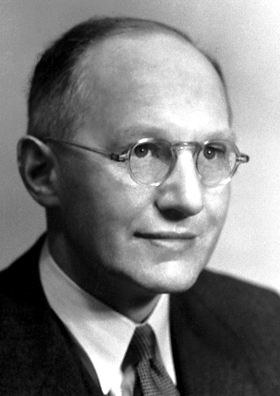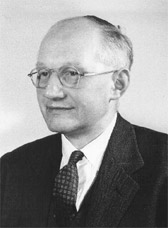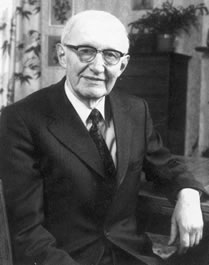<Back to Index>
- Physicist Ernest Thomas Sinton Walton, 1903
- Painter Alexander Maxovich Shilov, 1943
- Dictator of Syria Hafez al-Assad, 1930
PAGE SPONSOR



Ernest Thomas Sinton Walton (6 October 1903 – 25 June 1995) was an Irish physicist and Nobel laureate for his work with John Cockcroft with "atom - smashing" experiments done at Cambridge University in the early 1930s, and so became the first person in history to artificially split the atom, thus ushering the nuclear age. Walton is the only Irishman to have won a Nobel Prize in science.
Ernest Walton was born in Abbeyside, Co. Waterford, Ireland, to a Methodist minister father, Rev. John Walton (1874 – 1936) and Anna Sinton (1874 – 1906). In those days a general clergyman's family moved once every three years, and this practice carried Ernest and his family, while he was a small child, to Counties Limerick and Monaghan. He attended day schools in counties Down, Tyrone, and Wesley College Dublin before becoming a boarder at Methodist College Belfast in 1915, where he excelled in science and mathematics.
In 1922 Walton won scholarships to Trinity College, Dublin for the study of mathematics and science. He was awarded bachelor's and master's degrees from Trinity in 1926 and 1927, respectively. During these years at college, Walton received numerous prizes for excellence in physics and mathematics (seven prizes in all). Following graduation he was accepted as a research student at Trinity College, Cambridge, under the supervision of Sir Ernest Rutherford, Director of Cambridge University's Cavendish Laboratory. At the time there were four Nobel Prize laureates on the staff at the Cavendish lab and a further five were to emerge, including Walton and John Cockcroft. Walton was awarded his Ph.D. in 1931 and remained at Cambridge as a researcher until 1934.
During the early 1930s Walton and John
Cockcroft collaborated to build an apparatus that
split the nuclei of lithium atoms by
bombarding them with a stream of protons accelerated
inside a high voltage tube (700 kilovolts). The
splitting of the lithium nuclei produced helium nuclei. This
was experimental verification of theories about atomic structure that had
been proposed earlier by Rutherford, George Gamow, and others. The
successful apparatus - a type of particle accelerator now
called the Cockcroft - Walton
generator -
helped to usher in an era of particle - accelerator -
based experimental nuclear physics. It was this research
at Cambridge in the early 1930s that won Walton and
Cockcroft the Nobel Prize in physics in 1951.
Ernest Walton returned to
Ireland in 1934 to become a Fellow of Trinity
College Dublin in the physics department, and in
1946 was appointed professor with the title Erasmus
Smith's Professor of Natural and Experimental
Philosophy. Walton's
lecturing was considered outstanding as he had the
ability to present complicated matters in simple
and easy to understand terms. His research
interests were pursued with very limited
resources, but yet he was able to study, in the
late 1950s, the phosphorescent effect
in glasses, secondary - electron emissions from
surfaces under positive ion bombardment,
radiocarbon dating and low level counting, and the
deposition of thin films on glass.
Ernest Walton married Freda Wilson, daughter of an Irish Methodist Minister, on 23 August 1934. They had five children, Dr. Alan Walton (college lecturer in physics, Magdalene College, Cambridge), Mrs Marian Woods, Professor Philip Walton, Professor of Applied Physics, National University of Ireland, Galway, Jean Clarke and Winifred Walton.
Walton was a longtime member of the board of governors of Wesley College, Dublin.
Although he retired from Trinity College
Dublin in
1974, he retained his association with the Physics
Department at Trinity up to his final illness. His
was a familiar face in the tea room. Shortly
before his death he marked his lifelong devotion
to Trinity by presenting his Nobel medal and
citation to the college. He died
in Belfast on
June 25, 1995, aged 91 and is buried in Deansgrange
Cemetery, Dun Laoghaire -
Rathdown, south County Dublin. He was widely
respected, much admired, and regarded as a modest,
unassuming man.
Walton and John Cockcroft were recipients of the 1951 Nobel Prize in Physics for their "work on the transmutation of the atomic nuclei by artificially accelerated atomic particles" (popularly known as splitting the atom). They are credited with being the first to disintegrate the lithium nucleus by bombardment with accelerated protons (or hydrogen nuclei) and identifying helium nuclei in the products. More generally, they had built an apparatus which showed that nuclei of various lightweight elements (such as lithium) could be split by fast moving protons.
Walton and Cockcroft received the Hughes Medal of the Royal Society of London in 1938. In much later years - and predominantly after his retirement in 1974 - Walton received honorary degrees or conferrals from numerous Irish, British, and North American institutions.
The "Walton Causeway Park" in Dungarvan, Co. Waterford was dedicated in his honor with Walton himself attending the ceremony in 1989. After his death the Waterford Institute of Technology named a large building the ETS Walton Building and a plaque was placed on the site of his Co. Waterford birthplace.
Other honours for Walton include the Walton Building at Methodist College, Belfast, the school where he had been a boarder for five years, and a memorial plaque outside the main entrance to Methodist College. Also, there is the Walton Prize for Physics at Wesley College, where he attended and for many years served as Chairman of the Board of Governors, and a prize with the same name at Methodist College, which is awarded to the pupil who obtains the highest marks in A Level Physics.